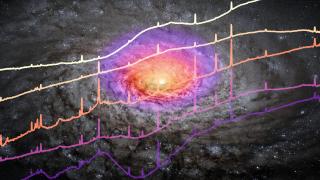Bibcode
Peralta de Arriba, L.; Alonso-Herrero, A.; García-Burillo, S.; García-Bernete, I.; Villar-Martín, M.; García-Lorenzo, B.; Davies, R.; Rosario, D. J.; Hönig, S. F.; Levenson, N. A.; Packham, C.; Ramos Almeida, C.; Pereira-Santaella, M.; Audibert, A.; Bellocchi, E.; Hicks, E. K. S.; Labiano, A.; Ricci, C.; Rigopoulou, D.
Referencia bibliográfica
Astronomy and Astrophysics
Fecha de publicación:
7
2023
Revista
Número de citas
19
Número de citas referidas
16
Descripción
We present a spatially resolved study of the ionized gas in the central 2 kpc of the Seyfert 2 galaxy NGC 2110 and investigate the role of its moderate-luminosity radio jet (kinetic radio power of Pjet = 2.3 × 1043 erg s−1). We used new optical integral-field observations taken with the MEGARA spectrograph at the Gran Telescopio Canarias, which cover the 4300 − 5200 Å and 6100 − 7300 Å ranges with a spectral resolution of R ≃ 5000 − 5900. We fitted the emission lines with a maximum of two Gaussian components, except at the position of the active galactic nucleus (AGN), where we used three. Aided by existing stellar kinematics, we used the observed velocity and velocity dispersion (σ) of the emission lines to classify the different kinematic components. The disk component is characterized by lines with σ ≃ 60 − 200 km s−1. The outflow component has typical values of σ ≃ 700 km s−1 and is confined to the central 2.5″ ≃ 400 pc, which is coincident with the linear part of the radio jet detected in NGC 2110. At the AGN position, the [O III]λ5007 line shows high velocity components that reach at least 1000 km s−1. This and the high velocity dispersions indicate the presence of outflowing gas outside the galaxy plane. Spatially resolved diagnostic diagrams reveal mostly low ionization (nuclear) emitting region-like excitation in the outflow and some regions in the disk, which could be due to the presence of shocks. However, there is also Seyfert-like excitation beyond the bending of the radio jet, which probably traces the edge of the ionization cone that intercepts with the disk of the galaxy. NGC 2110 follows the observational trends between the outflow properties and the jet radio power found for a few nearby Seyfert galaxies. All these pieces of information suggest that part of the observed ionized outflow in NGC 2110 might be driven by the radio jet. However, the radio jet was bent at radial distances of ∼200 pc (in projection) from the AGN, and beyond there, most of the gas in the galaxy disk is rotating.
Proyectos relacionados

Actividad Nuclear en Galaxias: una Perspectiva 3D del Núcleo y su Entorno
Nuestro proyecto puede dividirse en dos líneas principales de investigación. En primer lugar, el estudio de los vientos producidos por cuásares luminosos oscurecidos y del impacto que estos tienen en sus galaxias anfitrionas (retroalimentación del AGN). Para ello hemos obtenido observaciones en el óptico e infrarrojo cercano con el Gran Telescopio
Cristina
Ramos Almeida